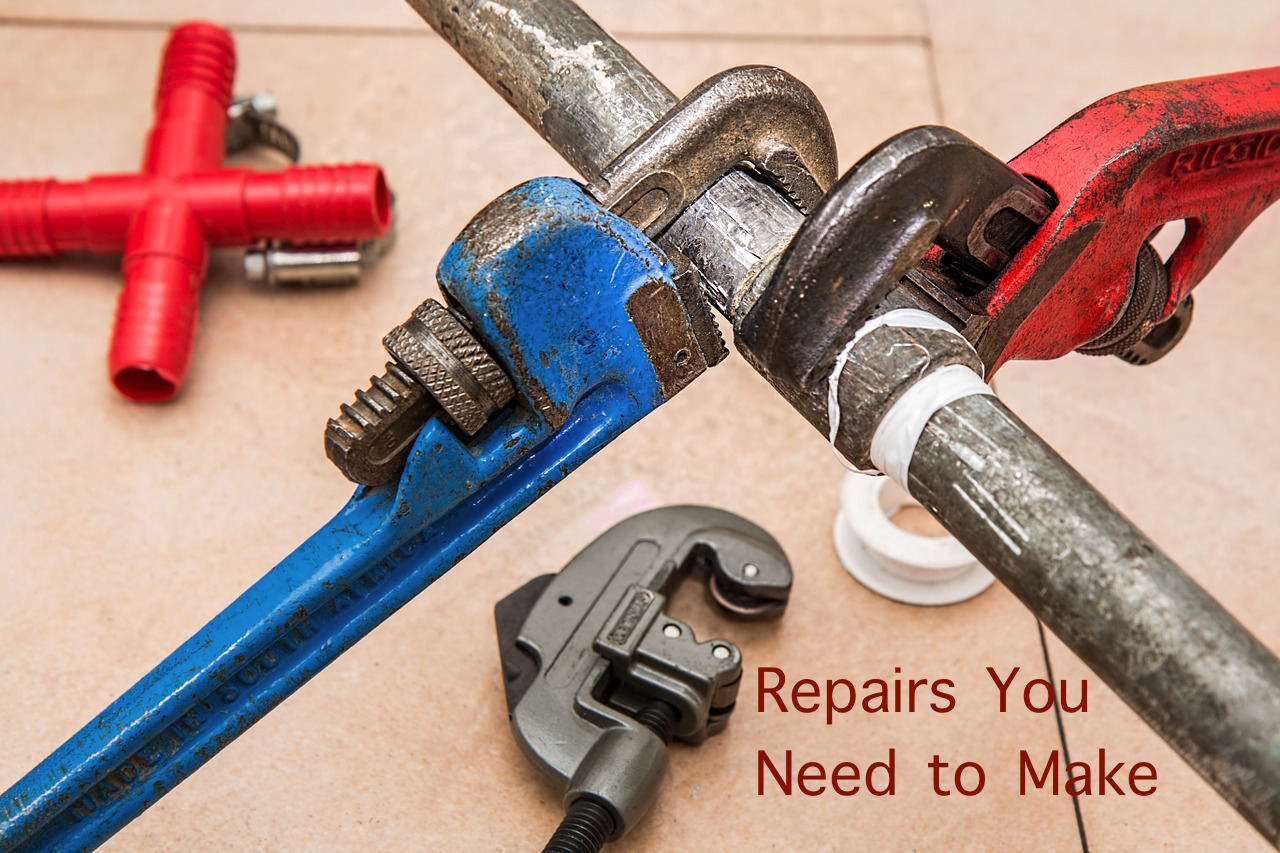Repairs You Need To Make
Repairs You Need To Make
In my blog post last week, I talked about the benefits of staging your home on selling price and time to sell. Buyers like staged homes. But staging generally starts with a sellable home. Staging a home that has obvious deferred maintenance is like putting lipstick on a pig. In this post I will identify some repairs you need to make before selling your home.
Sellers need to address deferred maintenance. That does not mean that sellers should renovate their home before selling. This is really the difference between functional obsolescence and deferred maintenance. Sellers will address functional obsolescence by redesigning aspects of the home to make it more modern. For example, central air conditioning is a modern feature. A home without central air conditioning may be considered out of step with the demands of modern buyers. That is not deferred maintenance. If the air conditioning is installed but does not work would be considered deferred maintenance. Sellers need to be wary of the return they may achieve from addressing functional obsolescence in their home in an attempt to sell it.
Failure to address deferred maintenance will be discovered either by the buyer or by the inspector the buyer hires. In either case, the result will be that you will spend more money to address the problem than if corrected before the house is listed. Inspectors may view very simple deferred maintenance issues as the visible evidence of even greater latent issues. Generally, the buyer will exaggerate the costs and impacts of deferred maintenance in order to improve their negotiating position.
Once you have determined the items you will repair then you should consider what you will also do to stage the house to maximize the selling price. In some cases, combining some activities will be more cost effective.
General Maintenance
There are a number of general maintenance actions you can take that cost little, take little time but remove a headache during the selling and closing of your home.
Replace burnt out light bulbs. The inspector will imagine all manner of electrical system issues if more than one bulb needs replacement. When you replace bulbs, it is a good idea to ensure the bulbs are bright and of the same color.
Replace the fan filter on the central forced air unit. Inspectors will check this. But they will also test the air flow at the outlets, looking for blockages.
Ensure smoke detectors and carbon monoxide detectors are functioning. Press the test button and replace battery if necessary.
Check every faucet and drain should be checked to ensure they are functioning correctly. Also check the fittings around the hot water tank, water filtrations systems, and boilers, if present. Every buyer is rightfully paranoid about visible water damage.
Interior Repairs
Drywall Cracks, Holes and Stains
Drywall and the associated compound finish is very brittle. It is firmly attached to the wood frame by many screws and moves as the wood changes shape due to absorption and loss of moisture through the seasons. The causes crack in the drywall and finish. They are not structural failures but they have a significant impact on buyers. These cracks should be fixed and painted.
Investigate the cause of any water stains. In some cases, the stain may be a result of a one-time event, such as overflowing the toilet. Repair any resulting water stains such as around baseboards or in the ceiling. This will avoid a difficult discussion the a suspicious buyer!
If the water stain is a result of some other issue, consider the repair. These may be worth considering, but they may also be costly.
Kitchen
Cabinet hardware should be checked to ensure the doors and drawers all function correctly. It is a good idea to check all the hinges and ensure the doors are not loose and misaligned. The European hardware used in most homes is easily adjusted.
Cabinets are likely to be chipped and shelves are likely to be scratched and worn Laminate counters are often worn or chipped or flaked. If the seams where laminate counters meet have absorbed water, the surface may not be flat. If these are near the sink, the buyer may assume that there is a water issue. More likely, the counter is simply beyond its useful life. Most new construction uses some kind of solid countertop such as granite. Replacing the countertop with another laminate countertop is unlikely to wow the buyer. For the most part, failures such as these can only be resolved by renovating the kitchen.
The base cabinet under the sink needs attention. This area is often untidy and messy. At the best of times this area appears to have signs of water damage. Ensure that all the pipes are tight and not leaking. Repair the faucet if it leaks or is loose in counter or sink. Any sign of previous water damage need to be removed. Failure to do so will result in some finding by the pest or building inspection.
Bathrooms
Repair or replace leaking faucets.
Chipped and scarred porcelain in the tub or sink is unsightly and prone to rusting. Home repair kits are available. Professional resurfacing can be a very cost effective way to eliminate this issue.
Ensure that all the tile and grout is in good condition, especially anywhere near water sources. Cracks in tub and shower tile grout are usually noticed by buyers or inspectors. They create suspicion about the cause and the impact. Inspectors will assume there is a mold issue to be addressed. These cracks are usually a result of using grout in corners in showers. While grouting corners is common practice, grout in corners is highly likely to crack and should be replaced by caulk.
Caulk around tubs, sinks and toilets needs to be in good repair. Inspectors look for gaps in the seal due to shrinkage or tearing. The inspector will identify this as a possible mold source.
Loose toilet seats need to be tightened. If they are damaged they should be replaced.
Ensure that the drains are functioning correctly. Normally, the drain can be quickly corrected. Even if a plumber is required, the correction is not too expensive compared to the negotiation!
Exterior Repairs
Painting
Routine maintenance to the exterior of your home is frequently delayed. This often results in water damage to wood on the outside such as trim, siding garage doors. Worse though is damage to the structure and interior of the home dues to failure of the outside components.
Scaled and cracked paint on wood trim, garage doors and siding leaves an exaggerated poor impression. Correcting this is not expensive or difficult and eliminates concern on the part of buyers that greater evils lurk behind the scene.
Rotted, split, or broken trim and other wood can be more expensive and difficult to repair. It may also result in mold inside the structure or even apparent damage to the interior. The amount of money that should be spent needs to be assessed on a case by case basis.
Trimming Overgrown Trees
Unkempt trees near the house are often viewed as a hazard to the roof and other exterior parts of the house. Trees invite inspects, birds, rodents to shelter near the house. Also the leaves and debris from the trees clogs gutters and damages shingles. And of course having a branch fall through the attic while the house is on the market would not be convenient!
While it is not directly related, buyers may associate an overgrown tree with root problems with foundation or plumbing.
Cleaning and Repairing Gutters
An inspector will associate clogged or broken gutters with potential roof, trim, siding and drainage issues. These need to be in good repair.
Broken Sidewalks, Railings, Stairs and Fences
From the perspective of essential repairs, the house must be safe. Remember you are inviting people to your house that you do not know. Any risk to any member of the public while showing your home must be addressed. No one wants the burden of an injury.
Beyond safety, the buyer will base their first impression when the park at the curb. Obvious disrepair will likely keep the buyer in their car.
How Can Your Realtor® Help?
Your Realtor understands that completing the sale after contract is potentially difficult. Issues which arise after the contract is written is another opportunity for buyers to negotiate with you. You do not want your house back on the market.
Your Realtor should encourage an inspection of your home by a qualified inspector before the home is listed if there is any reason to believe there are issues. This will permit you properly identify all the repairs that may be requested by a buyer and ensure that you properly disclose issues to the buyer. Even if you choose to make no repairs, being forewarned will allow you to price accordingly and be prepared for negotiations.
In California, your Realtor is also required to perform a visual inspection and disclose any apparent issues to the buyer.
Your Realtor should be able to provide a list of qualified inspectors and contractors who can support the repairs. However, note that the state of your house is your responsibility. You may choose to make repairs or not. You will have difficult decisions to make about how much money to invest in repairs.
By completing the repairs you need to make , your chances of getting a completed sale on time at your price are much better.

